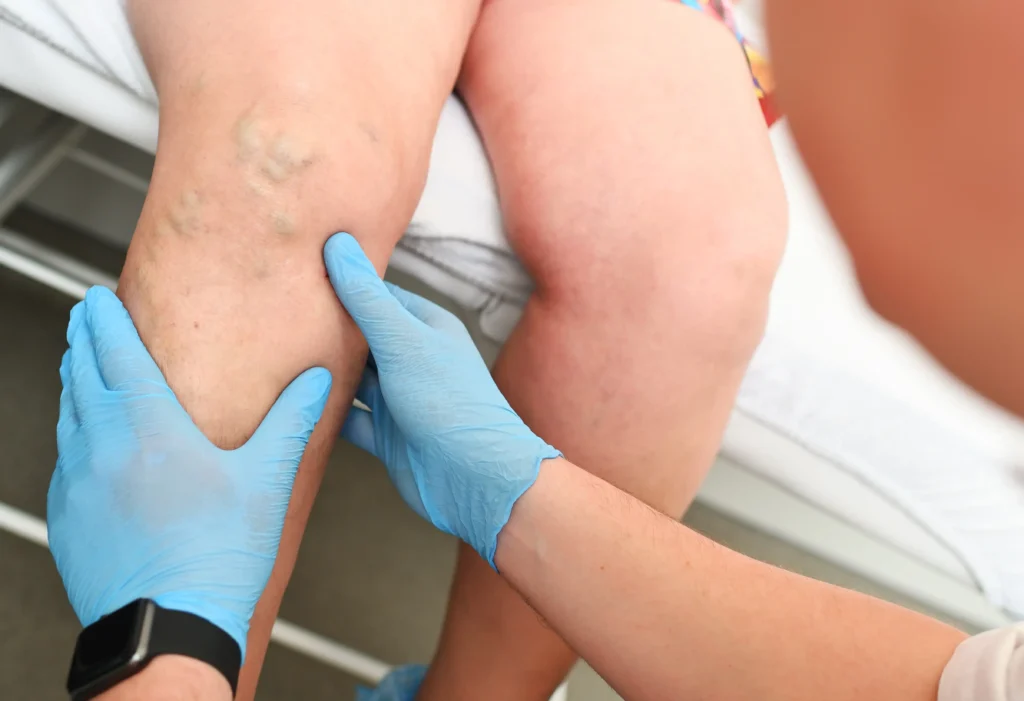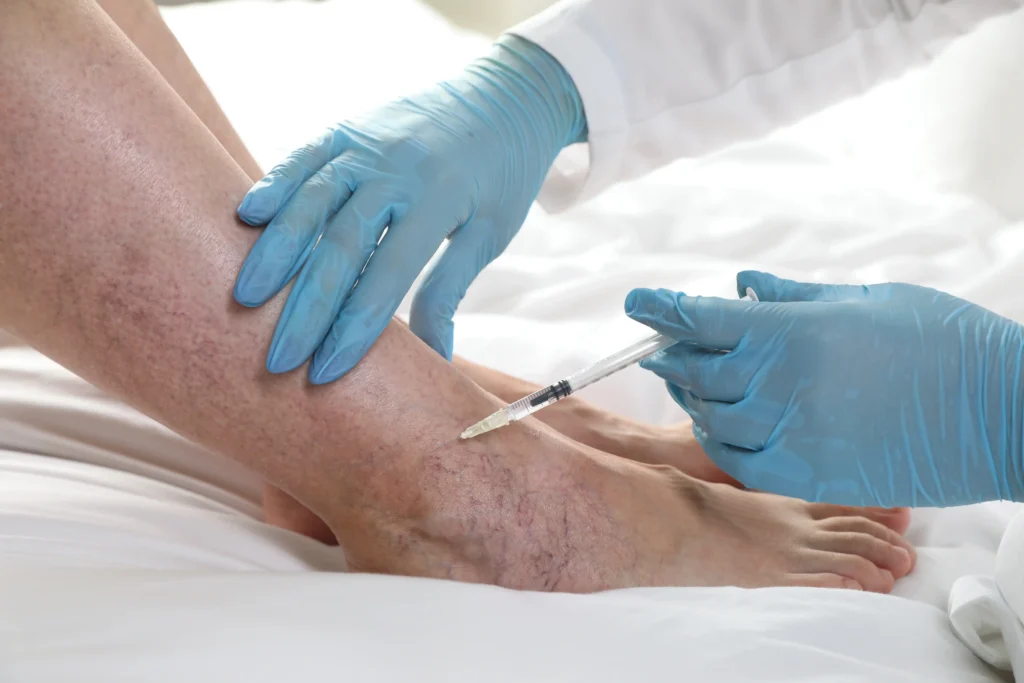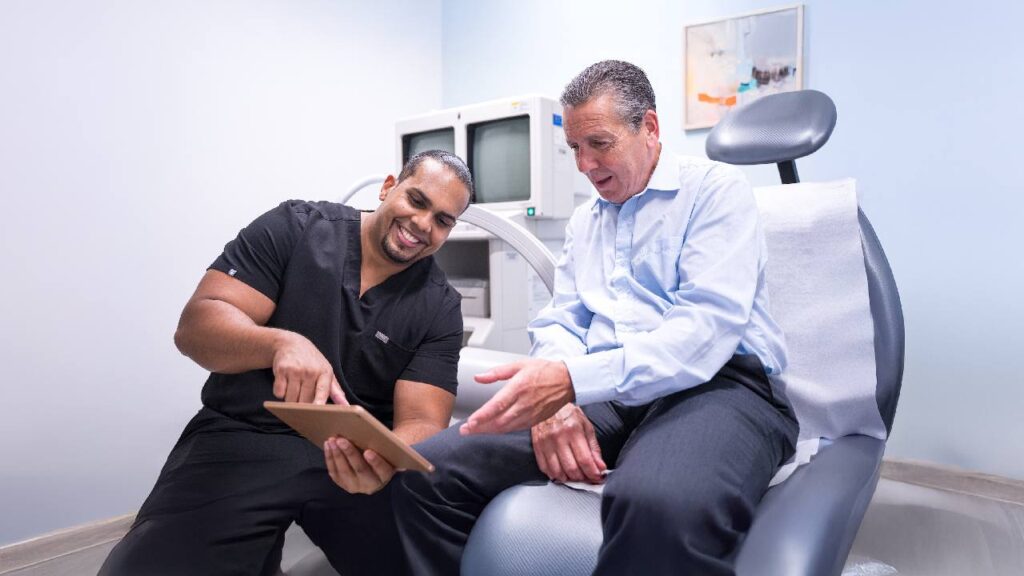Know Your Options | 4 Ways to Treat Spider Veins in Clifton, New Jersey
Summary
If you’re exploring treatment for spider veins in Clifton, NJ, your options may include sclerotherapy, endovenous ablation, ambulatory phlebectomy, and compression stockings. The best approach depends on whether you have underlying vein disease, which is diagnosed with an ultrasound, and whether you have accompanying varicose veins as well. At Vein Treatment NJ in Clifton, our board-certified vein doctors create personalized plans for your specific needs.
Best Treatment for Spider Veins in Clifton, NJ
You might notice thin, web-like veins appearing on your legs, ankles, or even your face. While spider veins may seem like a cosmetic problem, they can also be symptomatic of a more serious underlying condition known as chronic venous insufficiency. Left untreated, this condition can worsen over time, causing leg heaviness, swelling, and even varicose veins. That’s why it’s important to explore your options early.
At Vein Treatment NJ in Clifton, located at 1117 US-46, Suite 205, Clifton, NJ 07013, near Clifton Commons Shopping Center, you’ll find state-of-the-art care led by Harvard-trained, board-certified vein specialists. Our vein doctors offer a range of safe, minimally invasive treatments for spider veins and the conditions that cause them. In this article, you’ll learn about four effective ways to manage spider veins and which approach might be right for you.
Sclerotherapy For Spider Veins
Sclerotherapy is the most common spider vein procedure in Clifton. It works by injecting a carefully measured medical solution, often a saline-based or foam sclerosant, directly into the affected spider veins. This solution irritates the inner lining of the vein wall, causing it to swell, collapse, and eventually seal shut. Once closed, the treated vein can no longer carry blood, and circulation naturally reroutes through healthier surrounding veins.
Over the following weeks, your body gradually breaks down and reabsorbs the closed vein, making it fade from the skin’s surface. The result is clearer, healthier-looking legs with improved circulation. Because the injection targets only the abnormal veins, nearby healthy veins remain untouched. The procedure is quick, performed in-office without anesthesia, and most patients return to daily activities right after treatment. Multiple sessions may be recommended depending on the number and size of the spider veins being treated.
Endovenous Ablation (Radiofrequency Or Laser) For The Underlying Vein Disease
Spider veins don’t always appear in isolation. They’re often a surface symptom of underlying vein disease, which must be addressed for long-term results. If your vein doctor treats spider veins without addressing the root cause, they may simply come back later. One of the most effective treatments for chronic venous insufficiency is endovenous ablation.
Endovenous ablation targets the deeper diseased veins that often cause spider veins. Guided by ultrasound, your vein doctor inserts a thin catheter into the faulty vein through a tiny puncture in the skin. Once positioned, either radiofrequency energy or laser energy is delivered along the vein wall, gently heating it until it collapses and seals shut.
This closure forces blood to flow into nearby healthy veins, immediately improving circulation. The treated vein then breaks down naturally and is absorbed by your body. The procedure is performed under local anesthesia, takes less than an hour, and requires no hospital stay. Since it addresses the root cause, ablation provides lasting relief from symptoms like swelling, heaviness, and aching legs, while also preventing new spider veins from forming.
Ambulatory Phlebectomy For Accompanying Varicose Veins
When spider veins appear alongside larger, bulging varicose veins, your vein doctor may recommend ambulatory phlebectomy. During this minimally invasive procedure, the vein specialist makes tiny incisions (so small they rarely require stitches) near the surface of the skin. Using a hook-like instrument, the problematic varicose vein is gently removed in segments.
Because the incisions are so small, there’s minimal scarring and very little discomfort. Patients typically resume walking immediately after the procedure. Removing varicose veins not only improves appearance but also eliminates the throbbing, heaviness, and itching they can cause. Ambulatory phlebectomy is considered a cosmetic treatment for bulging varicose veins, so it’s often performed after ablation procedures for underlying vein disease.
Compression Stockings For Symptom Relief
Compression stockings are often recommended as a conservative first step in vein care. These medical-grade garments apply graduated pressure to your legs: tighter at the ankle and looser higher up. This graduated pressure improves blood flow back toward the heart and reduces the pooling of blood in diseased veins.
While compression stockings don’t remove or close spider veins, they help relieve common symptoms like swelling, aching, and leg fatigue. They are especially beneficial for people who spend long hours sitting or standing. Many insurance providers require a trial period before approving coverage for procedures like ablation. Though not a definitive treatment, stockings play an important role in managing discomfort and supporting your overall vein health.
Which Is The Best Treatment For Spider Veins In Clifton, NJ?
You might wonder: what’s the single “best” treatment for spider veins in Clifton, NJ? The truth is, there isn’t one universal answer. The best treatment depends entirely on your unique vein health and whether you have underlying venous insufficiency.
That’s why every patient begins with a comprehensive duplex ultrasound diagnosis. This imaging test allows our vein doctors to see below the skin’s surface and identify the root cause of your spider veins. For some, sclerotherapy alone is enough. For others, a combination of endovenous ablation, phlebectomy, and cosmetic procedures provides the best results.
The most effective spider vein treatment is often a personalized plan that addresses both cosmetic concerns and underlying medical issues. The good news? Most vein treatments are covered by insurance, and our team at Vein Treatment NJ helps you navigate coverage details before your first appointment.
Schedule Your Consultation At Vein Treatment NJ In Clifton
Ready to explore your options? At Vein Treatment NJ in Clifton, you’ll find expert care in a convenient location at 1117 US-46, Suite 205, just minutes from Clifton Commons and Montclair State University. Our board-certified vein specialists use the latest minimally invasive techniques to provide safe, effective, and insurance-covered treatments.
Whether you need spider vein therapy in Clifton, advanced ablation procedures, or supportive care, we’ll design a personalized plan for your health needs and cosmetic goals. With additional locations across New Jersey, including Paramus, Woodbridge, and Scotch Plains, you can easily access quality vein care near you. Contact us to schedule a consultation today and learn about your options for spider vein removal.
FAQs
Are Spider Veins Dangerous Or Just Cosmetic?
Spider veins often appear to be a cosmetic issue, but they can sometimes be a sign of chronic venous insufficiency. If you also experience leg heaviness, swelling, or leg fatigue, it’s important to get evaluated promptly.
How Long Does Spider Vein Therapy Take?
Most spider vein procedures in Clifton take less than an hour. Treatments like sclerotherapy or ablation are performed in-office, and you can usually return to normal activities the same day.
Is Treatment For Spider Veins in Clifton, NJ, Covered By Insurance?
Insurance coverage depends on the underlying cause. If your spider veins are linked to chronic venous insufficiency, your vein treatment is almost always covered. Even sclerotherapy, which is often considered a cosmetic procedure, may be covered as part of a comprehensive plan. Contact us to verify your insurance details.
Will My Spider Veins Come Back After Treatment?
The treated spider veins won’t return, but you may develop new ones over time, especially if the underlying vein disease isn’t addressed. That’s why a full diagnostic ultrasound is so important.
Do Compression Stockings Cure Spider Veins?
Compression stockings help relieve symptoms but don’t cure spider veins. They are best used alongside minimally invasive procedures for lasting results.





